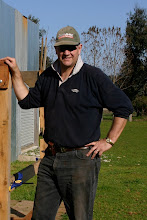S
A couple of weeks back we sold Moora Farm.
As I said on Facebook at the time:
Somewhere in the past I remember reading a phrase expressing someone's love for and connection with a particular place. It was something like ... "I belong to it, like it belongs to me."
Today, as we leave Moora Farm for the last time as its owners, I feel like I will still 'belong' to Moora Farm even when it no longer belongs to me. I know almost every inch of it and take some satisfaction that the land is now in better heart than when I arrived.
But perhaps the best part of the day was to see the anticipation and excitement in the eyes of the new owners as they did their final inspection. May they to end up 'belonging' to Moora Farm ... as we always will.
I seems like a sensible time also to cease posting to this blog and set up a new one based on what we are planning for our new (old) farm at Grenville in Victoria. Back in 1998 we established P. Radiata and E. Globulus plantations on a leased property. A few years later we bought the land.
We are now engaged in doing several things:
We now know the property as Carmyllie - and, in due course, I will start a blog called Carmyllie Forest & Farm. I will post a link when it is up and going.
A couple of weeks back we sold Moora Farm.
As I said on Facebook at the time:
Somewhere in the past I remember reading a phrase expressing someone's love for and connection with a particular place. It was something like ... "I belong to it, like it belongs to me."
Today, as we leave Moora Farm for the last time as its owners, I feel like I will still 'belong' to Moora Farm even when it no longer belongs to me. I know almost every inch of it and take some satisfaction that the land is now in better heart than when I arrived.
But perhaps the best part of the day was to see the anticipation and excitement in the eyes of the new owners as they did their final inspection. May they to end up 'belonging' to Moora Farm ... as we always will.
I seems like a sensible time also to cease posting to this blog and set up a new one based on what we are planning for our new (old) farm at Grenville in Victoria. Back in 1998 we established P. Radiata and E. Globulus plantations on a leased property. A few years later we bought the land.
We are now engaged in doing several things:
- managing the existing plantations as well as we possibly can;
- continuing to establish other forest crops;
- working (carefully) away from an industrial plantation forestry model towards a European sustainable yield model; and
- planting a farm amongst the trees on 'spare' land that was formerly quite badly affected by salinity.
We now know the property as Carmyllie - and, in due course, I will start a blog called Carmyllie Forest & Farm. I will post a link when it is up and going.











































